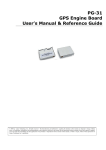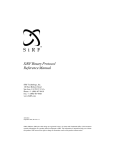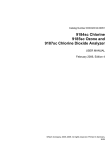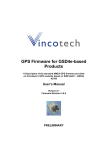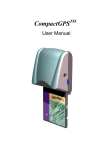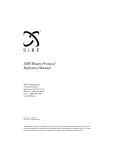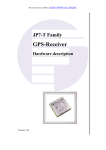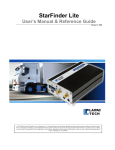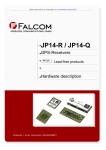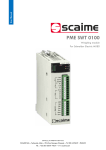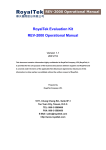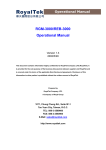Download PG-31 GPS Engine Board
Transcript
PG-31
GPS Engine Board
User’s Manual & Reference Guide
www.laipac.com
Laipac Technology,Inc.
55 West Beaver Creek Rd., Unit 1, Richmond Hill, Ontario, L4B 1K5 Canada
Tel:1-905-762-1228 Fax:1-905-763-1737
© 2005 by Laipac Technology, Inc. All rights reserved – The Specifications and information regarding the products in this manual are subjected to change
without notice. All statements, information, and recommendations in this manual are believed to be accurate but are represented without warranty of any
kind, express or implied, users must take full responsibility for their applications of any Products - Reproduction of the contents of this manual, in whole
or in part, without written permission of Laipac Technology, Inc. is prohibited.
PG-31 GPS Engine Board User’s Manual & Reference Guide
1. Introduction to PG GPS series
4
PG-31 GPS Receiver
4
Quick View on Specifications
2. Specifications
PG-31
4
5
5
3. Interface Description and Options
Physical Diagram
Digital Interface Connector pin description
PG-31
Option Descriptions
TricklePower Option
RS-232 I/O Option
4. SiRF Binary Protocol Specification
6
6
6
6
8
8
9
9
Protocol Layers
Transport Message
Transport
Message Validation
9
9
9
9
Payload Length
Payload Data
Checksum
Input Messages for SiRF Binary Protocol
Initialize Data Source - Message I.D. 128
Switch To NMEA Protocol - Message I.D. 129
Set Almanac – Message I.D. 130
Software Version – Message I.D. 132
Set DGPS Source – Message I.D. 133.
Set Main Serial Port - Message I.D. 134
Mode Control - Message I.D. 136
DOP Mask Control - Message I.D. 137
DGPS Control - Message I.D. 138
Elevation Mask – Message I.D. 139
Power Mask - Message I.D. 140
Editing Residual– Message I.D. 141
Steady State Detection - Message I.D. 142
Static Navigation– Message I.D. 143
Poll Clock Status – Message I.D. 144
Set DGPS Serial Port - Message I.D. 145
Poll Almanac - Message I.D. 146
Poll Ephemeris - Message I.D. 147
Flash Update - Message I.D. 148
Set Ephemeris - Message I.D. 149
Switch Operating Modes - Message I.D. 150
Set TricklePower Parameters - Message I.D. 151
Computation of Duty Cycle and On Time
Push-to-Fix
Poll Navigation Parameters - Message I.D. 152
Set UART Configuration – Message I.D.165
Low Power Acquisition parameters - Message I.D. 167
Output Messages for SiRF Binary Protocol
Measure Navigation Data Out - Message I.D. 2
Measured Tracker Data Out - Message I.D. 4
Raw Tracker Data Out - Message I.D. 5
9
10
10
10
11
11
12
13
13
15
15
16
16
17
17
17
17
17
18
18
18
19
19
20
20
21
21
22
22
22
24
24
25
26
29
© 2005 by Laipac Technology Inc. All Rights Reserved.
Page 2of 46
PG-31 GPS Engine Board User’s Manual & Reference Guide
Software Version String (Response to Poll) - Message I.D. 6
Response: Clock Status Data - Message I.D. 7
50 BPS Data – Message I.D. 8
CPU Throughput – Message I.D. 9
Command Acknowledgment – Message I.D. 11
Command Acknowledgment – Message I.D. 12
Visible List – Message I.D. 13
Almanac Data - Message I.D. 14
Ephemeris Data (Response to Poll) – Message I.D. 15
Ok To Send - Message I.D. 18.
Navigation Parameters (Response to Poll) – Message I.D. 19.
Nav. Lib. Measurement Data – Message I.D.28
Nav. Lib. DGPS Data – Message I.D.29
Nav. Lib. SV State Data – Message I.D.30
Nav. Lib. Initialization Data – Message I.D.31
Development Data – Message I.D. 255
Additional Information
TricklePower Operation in DGPS Mode
GPS Week Reporting
NMEA Protocol in TricklePower Mode
5. NMEA Input/Output Messages
NMEA Output Messages
GGA — Global Positioning System Fixed Data
GLL— Geographic Position - Latitude/Longitude
GSA— GNSS DOP and Active Satellites
GSV— GNSS Satellites in View
RMC— Recommended Minimum Specific GNSS Data
VTG— Course Over Ground and Ground Speed
SiRF Proprietary NMEA Input Messages
Transport Message
SiRF NMEA Input Messages
Set Serial Port
Navigation Initialization
Set DGPS Port
Query/Rate Control
LLA Navigation Initialization
Development Data On/Off
© 2005 by Laipac Technology Inc. All Rights Reserved.
28
28
28
29
29
30
30
31
31
31
32
33
35
36
37
37
38
38
38
38
39
39
39
39
40
41
41
42
42
42
43
43
43
44
44
45
46
Page 3of 46
PG-31 GPS Engine Board User’s Manual & Reference Guide
Chapter 1 Introduction to PG-31 GPS Receiver
PG-31 GPS Receiver Module
Features
SiRF Star II/LP (low power) chipset with embedded ARM7TDMI CPU available for
customized applications through firmware
12 parallel satellite-tracking channels for fast acquisition and re-acquisition
Compact size (only 30.6*26*9.8mm, includes RF shield and connector)
High speed signal acquisition using 1920 time/frequency search channels
Built-in WAAS/EGNOS demodulator
Low power consumption with Advanced TricklePower and Push-To-Fix mode
Optional Rechargeable battery for memory and RTC backup as well as fast Time to
First Fix (TTFF)
Support NMEA-0183 v2.2 data protocol and SiRF binary code
Enhanced algorithms such as SnapLock and SnapStart provide superior navigation
performance in urban, canyon, and foliage covered environments
For Car Navigation, Marine Navigation, Fleet Management, AVL and Location-Based
Services, Auto Pilot, Personal Navigation, Touring Devices, and general tracking
devices/systems and Mapping applications
Specification overview
Snap Start < 3 sec (at < 25 minutes off period)
Hot Start 8 sec (typical)
Warm Start 38 sec (typical)
Cold Start 45 sec (typical)
Satellite Re-acquisition 100 ms
Time Accuracy 1 us
Channels 12 satellites
Position Accuracy 25m CEP without SA
Receiver L1, C/A code
Protocol NMEA-0183 V2.2, 4800, 8, N, 1, GGA, GSA, GSV,
MC (VTG , GLL, RMS option) or SiRF Binary
Maximum Altitude < 18,000 m (60,000 feet)
Maximum Velocity < 515 m/s (1000knots)
Max. Update Rate 1 Hz
RF Connector MMCX
Interface Interface connector 20-pin (2X10) low profile socket, 1mm
Dimension 30.6mm(L)x26mm(W)x9.8mm(H)
Weight 8g
Firmware Upgrade Flash memory for programming software available
Time Mark Output 1 pulse/sec, aligned with GPS time +/ -0.1 usec
Operating Temperature –40ºC to +85ºC
Storage Temperature –45ºC to +100ºC
Operating Humidity 5% to 95%, No Condensing
Electrical specifications: Less than 70mA (without antenna)
Output terminal and definition: Interface connector 20-pin (2X10) low profile
socket, 1mm
© 2005 by Laipac Technology Inc. All Rights Reserved.
Page 4of 46
PG-31 GPS Engine Board User’s Manual & Reference Guide
Chapter 2 Specifications
PG-31
1. Electrical Characteristics
1.1 General
Frequency
C/A code
Channels
L1,1575.42MHz
1.023 MHz chip rate
12
1.2 Accuracy
Position
Velocity
Time
25 meters CEP without SA
0.1 meters/second, without SA
1 microsecond synchronized to GPS time
1.3 DGPS Accuracy
Position
Velocity
1 to 5 meters, typical
0.05 meters/second, typical
1.4 Datum
WGS-84
1.5 Acquisition Rate
Re-acquisition
Cold start
Warm start
Hot start
0.1 sec., average
45 sec., average
38 sec., average
8 sec., average
1.6 Dynamic Condition
1.7 Power
Altitude
Velocity
Acceleration
Jerk
Main Power
18,000 meters (60,000 Feet) max.
515 meters/sec. (1000 Knots) max.
4 g., max.
20 meters/sec.3 max.
3.3 Vdc ± 10%
1.8 External Reset
Supply Current,
continuous
Supply Current,
TricklePower mode
Backup Power
Backup Current
Active low input
1.9 Serial Port
Electrical interface
Protocol
NMEA output
DGPS protocol
1.10 Time-1PPS Pulse
Level
Pulse duration
Time reference
Measurements
2. Environmental Characteristics
~ 70 mA
~ 10 mA
+2.5V to 3.1V
10µA typical
Two full duplex serial communication (TTL
level or EIA RS-232 level - optional)
Design-in binary and NMEA-0183,
Version 2.20 with a baud rate selection
GGA, GLL, GSA, GSV, RMC, and VTG (on
customer request) Default six NMEA
(Baud Rate :4800)
RTCM SC-104, version 2.00, type 1,2 and
9
WAAS Supported
TTL
100 ms
positive edge
Aligned to GPS second, ± 1µ sec.
2.1 Temperature
Operating range
Storage range
–40ºC to +85ºC
–45ºC to +100ºC
2.2 Physical characteristics
Dimension
30.6mm(L)x26mm(w)x9.8mm(H)
© 2005 by Laipac Technology Inc. All Rights Reserved.
Page 5of 46
PG-31 GPS Engine Board User’s Manual & Reference Guide
Antenna connector
MMCX type
Interface connector
20-pin (2X10) low profile socket,
1mm
3. Antenna
Passive or Active Antenna
4. CPU Throughput
GPS Signal Processor & Integrated 16-bit,50 MHz ARM7TDMI
Software
CPU core & 1M DRAM memory
90% CPU throughput available for user
tasks
5. RF Interference
Assembled with fully shielded case design to withstand the
most interference
Chapter 3 Inter face and Options
This chapter describes the pin definitions of the interface connector and flexible options
of the PG-31.
Physical Diagram
Pin Definition of the Digital Interface Connector PG-31
Table 3-1 Pin List of the 20 pin Digital Interface Connector for the PG-31
Pin #
Name
Description
1
VCC
+3.3V +- 10% DC Power Input
2
TXA
Host Serial Data Output A
3
RXA
Host Serial Data Input A
4
TXB
Aux. Serial Data Output B
5
RXB
Aux. Serial Data Input B (DGPS)
6
TIMEMARK
1PPS Time Mark Output
7
BAT
Battery Backup Power Input
8
GPIOA
General Purpose Input/Output
9
RESET
Reset, Active Low
10
RESERVED
Reserved
© 2005 by Laipac Technology Inc. All Rights Reserved.
Page 6of 46
PG-31 GPS Engine Board User’s Manual & Reference Guide
11
GROUND
Ground
12
BOOTSEL
Internal/External Boot selective
13
GPIOB
General Purpose Input/Output
14
GPIOC
General Purpose Input/Output
15
GPIOD
General Purpose Input/Output
16
GPIOE
General Purpose Input/Output
17
GPIOF
General Purpose Input/Output
18
GPIOG
General Purpose Input/Output
19
GPIOH
General Purpose Input/Output
20
GROUND
Ground
*The Host Serial Data I/O is normally a CMOS logical high +3.3VDC.
*The Host Serial Data Input A (Pin# 3) should be set to high (ex.100KΩserial to +Vcc) when
not being used.
VCC
3.3 Vdc ±10% with a continuous Supply Current of ~ 70 mA.
Supply Current TricklePower mode ~ 10 mA (undetermined)
TXA
This is the main transmit channel and is used to output navigation and measurement data.
The Output is a TTL Level: Voh 2.4V, Vol 0.4V; Ioh=Iol=2mA.
RXA
This is the main receiver channel and is used by the PG-31 to receive software commands.
Receiver is TTL Level; Vih 0.7*VCC; Vil 0.3*VCC
TXB
For user’s application (not currently used).
RXB
This is the auxiliary receive channel and is used to input differential corrections to the
PG-31 board to enable DGPS navigation. Receiver is TTL Level; Vih 0.7*VCC; Vil 0.3*VCC.
TIMEMARK
This pin provides a one pulse-per-second output from the TMP board which is
synchronized to GPS time. This is not available in TricklePower mode.
© 2005 by Laipac Technology Inc. All Rights Reserved.
Page 7of 46
PG-31 GPS Engine Board User’s Manual & Reference Guide
BAT
This is the battery backup input that powers the SRAM and RTC when the main power is
removed. Typical current draw is 10uA. Without an external backup battery or supercap,
PG-31 will execute a cold start after every power on. To achieve the faster start-up offered
by a hot or warm start, either a battery backup must be connected or a supercap
installed. To maximize battery life, the battery voltage should not exceed the supply
voltage and should be between 2.5V and 3.1V.
GPIOA - GPIOH
These pins are connected to the digital interface connector for custom applications
RESET
This pin provides an active-low reset input to the PG-31 board. It causes the PG-31 board
to reset and start searching for satellites. If not utilized, it may be left open.
GND
GND provides the ground for the PG-31 board.
BOOTSEL
Internal/External Boot select. For normal internal boot mode, this pin is "High".
For normal operation, the user must leave this pin disconnected.
Option Descriptions
TricklePower Option
The design of the PG-31 includes all the functionality necessary to implement the
TricklePower mode. In this mode, the lowest average power dissipation is achieved by
powering down the board (after a position is determined) in such a manner that when it is
turned back on it can re-compute a position fix in the shortest amount of time. The
standard TricklePower operates in three states:
(1) Tracking State
In this state, the board is fully powered, tracking satellites and gathering data.
The time in this state is selectable via the SiRF demo software from 200-900ms.
After this time the measurements to calculate a position are ready.
(2) CPU State
In this state, the GRF1/LX (RF IC) has been turned off (by the control signal) removing
the clock to the GSP1/LX (Baseband ASIC). Without a clock, the GSP1/LX is effectively
powered down (although the RTC keeps running). The CPU is kept running to process the
GPS data until a position fix is determined and the result has been transmitted by the
serial communication interface.
(3) Trickle State
In this state, the CPU is in a low power standby state and the receiver clocks are off with
only the RTC clock active. After a set amount of time, the RTC generates an NMI signal to
wakeup the Hitachi microprocessor and set the receiver back to the tracking state. The
default time for each TricklePower state (and the approximate current consumed) is
shown below in Table 3-3. For example, with the TricklePower duty cycle at 20% the
average receiver power dissipation is approximately 165mW (50mA @ 3.3v) while
maintaining a one-second update rate.
© 2005 by Laipac Technology Inc. All Rights Reserved.
Page 8of 46
PG-31 GPS Engine Board User’s Manual & Reference Guide
Table 3-2 TricklePower Consumption
State
Time
+3.3V Current
Tracking
220mS
145mA
CPU
360mS
40mA
Trickle
420mS
0.5mA
Note: Table 3-2 does not include the external antenna power consumption.
RS-232 I/O Option
PG-31 allows for the populating of an RS-232 driver. Customers can request the
I/O to be TTL (5V) or RS-232 (12V).
Chapter 4 SiRF Binary Protocol Specification
The serial communication protocol is designed to include:
• Reliable transport of messages
• Ease of implementation
• Efficient implementation
• Independent from payload
Protocol Layers
Transport Message
Start
Sequence
0xA0 1 ,
0xA2
1. 0xYY denotes
Payload
Length Payload
Two-bytes
(15-bits)
a hexadecimal byte
Message
Payload
Checksum
Up to 2 10 –1
Two-bytes
(<1023)
(15-bits)
value. 0xA0 equals 160.
End
Sequence
0xB0,
0xB3
Transport
The transport layer of the protocol encapsulates a GPS message in two start characters
and two stop characters. The values are chosen to be easily identifiable and unlikely to
occur frequently in the data. In addition, the transport layer prefixes the message with a
two-byte (15-bit) message length and a two-byte (15-bit) checksum. The values of the
start and stop characters and the choice of a 15-bit value for length and checksum are
designed such that both message length and checksum can not alias with either the stop
or start codes.
Message Validation
The validation layer is a part of the transport layer, but operates independently. The byte
count refers to the payload byte length. Likewise, the checksum is a sum on the payload.
Payload Length
The payload length is transmitted high byte first followed by the low byte.
High Byte
< 0x7F
Low Byte
Any value
Even though the protocol has a maximum length of (2 15 -1) bytes, practical
considerations require the SiRF GPS module implementation to limit this value to a
smaller number. Likewise, the SiRF receiving programs (e.g., SiRFdemo) may also limit
the actual size to something less than this maximum.
© 2005 by Laipac Technology Inc. All Rights Reserved.
Page 9of 46
PG-31 GPS Engine Board User’s Manual & Reference Guide
Payload Data
The payload data follows the payload length. It contains the number of bytes specified
by the payload length. The payload data may contain any 8-bit value. Where multibyte values are in the payload data neither the alignment nor the byte order are
defined as part of the transport although SiRF payloads will use the big-endian
convention.
Checksum
The checksum is transmitted high order byte first followed by the low byte. This is the
so-called big-endian convention.
High Byte
< 0x7F
Low Byte
Any value
The checksum is a 15-bit checksum of the bytes in the payload data. The following
pseudo code defines the algorithm used.
Let ‘message’ be the array of bytes to be sent.
Let ‘msgLen’ be the number of bytes in the message array to be transmitted.
index = first
checkSum = 0
while index < msgLen
checkSum = checkSum + message[index]
checkSum = checkSum AND (2 15 -1)
Input Messages for SiRF Binary Protocol
Note – All input messages are sent in BINARY format. Table 4-1 lists the message list for
the SiRF input messages.
Table 4- 1 SiRF Messages - Input Message List
Hex
ASCII
Name
0 x 80
128
Initialize Data Source
0 x 81
129
Switch to NMEA Protocol
0 x 82
130
Set Almanac (upload)
0 x 84
132
Software Version (Poll)
0 x 85
133
Set DGPS Source Control
0 x 86
134
Set Main Serial Port
0 x 88
136
Mode Control
0 x 89
137
DOP Mask Control
0 x 8A
138
DGPS Mode
0 x 8B
139
Elevation Mask
0 x 8C
140
Power Mask
0 x 8D
141
Editing Residual (Not implemented)
0 x 8E
142
Steady-State Detection (Not implemented)
0 x 8F
143
Static Navigation
0 x 90
144
Poll Clock Status
0 x 91
145
Set DGPS Serial Port
0 x 92
146
Poll Almanac
0 x 93
147
Poll Ephemeris
0 x 94
148
Flash Update
0 x 95
149
Set Ephemeris (upload)
0 x 96
150
Switch Operating Mode
0 x 97
151
Set TricklePower Parameters
© 2005 by Laipac Technology Inc. All Rights Reserved.
Page 10of 46
PG-31 GPS Engine Board User’s Manual & Reference Guide
0
0
0
0
x
x
x
x
98
A5
A6
A7
152
165
166
167
Poll Navigation Parameters
Set UART Configuration
Set Message Rate
Low Power Acquisition Parameters
Initialize Data Source - Message I.D. 128
Table 4-2 contains the input values for the following example:
Warm start the receiver with the following initialization data: ECEF XYZ (-2686727
m, -4304282 m, 3851642 m), Clock Offset (75,000 Hz), Time of Week (86,400 s),
Week Number (924), and Channels (12). Raw track data enabled, Debug data
enabled.
Example:
A0A20019— Start Sequence and Payload Length
80FFD700F9FFBE5266003AC57A000124F80083D600039C0C33—
0A91B0B3— Message Checksum and End Sequence
Table 4- 2 Initialize Data Source
Binary
Name
Bytes
Scale
Message ID
1
ECEF X
4
ECEF Y
4
ECEF Z
4
Clock Offset
4
Time of Week
4
*100
Week Number
2
Channels
1
Reset Config.
1
Payload Length: 25 bytes
(Hex)
Example
80
FFD700F
FFBE5266
003AC57A
000124F8
0083D600
039C
0C
33
Units
Payload
Description
ASCII 128
meters
meters
meters
Hz
seconds
Range 1-12
See table Table 4-3
Table 4- 3 Reset Configuration Bitmap
Bit
Description
0
Data valid flag— set warm/hot start
1
Clear ephemeris— set warm start
2
Clear memory— set cold start
3
Factory Reset
4
Enable raw track data (YES=1, NO=0)
5
Enable debug data for SiRF binary protocol (YES=1, NO=0)
6
Enable debug data for NMEA protocol (YES=1, NO=0)
7
Reserved (must be 0)
Note
– If Nav Lib data is ENABLED then the resulting messages are enabled.
Clock Status (MID 7), 50 BPS (MID 8), Raw DGPS (17), NL Measurement Data
(MID 28), DGPS Data (MID 29), SV State Data (MID 30), and NL Initialize Data
(MID 31). All messages are sent at 1 Hz and the baud rate will be automatically set to
57600.
Switch to NMEA Protocol - Message I.D. 129
Table 4-4 contains the input values for the following example:
Request the following NMEA data at 4800 baud: GGA – ON at
1 sec, GLL – OFF, GSA - ON at 5 sec,
GSV – ON at 5 sec,
RMC-OFF, VTG-OFF
© 2005 by Laipac Technology Inc. All Rights Reserved.
Page 11of 46
PG-31 GPS Engine Board User’s Manual & Reference Guide
Example:
A0A20018— Start Sequence and Payload Length
8102010100010501050100010001000100010001000112C0— Payload
016AB0B3— Message Checksum and End Sequence
Table 4- 4 Switch To NMEA Protocol
Name
Bytes Binary (Hex)
Scale
Message ID
Mode
GGA Message 1
Checksum 2
GLL Message
Checksum
GSA Message
Checksum
GSV Message
Checksum
RMC Message
Checksum:
VTG Message
Checksum
Unused Field
Unused Field
Unused Field
Unused Field
Unused Field
Unused Field
Unused Field
Unused Field
Baud Rate
1
1
1
1
1
1
1
1
1
1
1
1
1
1
1
1
1
1
1
1
1
1
2
Units
Description
Example
81
02
01
01
00
01
05
01
05
01
00
01
00
01
00
01
00
01
00
01
00
01
12C0
ASCII 129
1/s
See Chapter 5 for format.
1/s
Se Chapter 5 for format.
1/s
See Chapter 5 for format.
1/s
See Chapter 5 for format.
1/s
See Chapter 5 for format.
1/s
See Chapter 5 for format.
Recommended value.
Recommended value.
Recommended value.
Recommended value.
Recommended value.
Recommended value.
Recommended value.
Recommended value.
38400, 19200,9600,4800,2400
Payload Length: 24 bytes
1. A value of 0x00 implies NOT to send message, otherwise data is sent at 1 message
every X seconds requested (i.e., to request a message to be sent every 5 seconds,
request the message using a value of 0x05.) Maximum rate is 1/255s.
2. A value of 0x00 implies the checksum NOT transmitted with the message (not
recommended). A value of 0x01 will have a checksum calculated and transmitted as
part of the message (recommended).
Note – In TricklePower mode, the update rate is specified by the user. When you
switch to NMEA protocol, the message update rate will be required again. The
resulting update rate is the product of the TricklePower Update rate AND the NMEA
update rate (i.e. TricklePower update rate = 2 seconds, NMEA update rate = 5
seconds, resulting update rate is every 10 seconds (2 X 5 = 10)).
Set Almanac – Message I.D. 130
This command enables the user to upload an almanac PG-31
example:
A0A20380 – Start Sequence and Payload Length
82xx… … … … … … … – Payload
xxxxB0B3 – Message Checksum and End Sequence
© 2005 by Laipac Technology Inc. All Rights Reserved.
Page 12of 46
PG-31 GPS Engine Board User’s Manual & Reference Guide
Table 4-5 Set Almanac message
Name
Bytes Binary
Scale
Message ID
1
Almanac
896
Payload Length: 897 bytes
(Hex)
Example
82
00
Units
Description
ACSII 130
Reserved
The almanac data is stored in the code as a 448 element array of INT16 values. These
448 elements are partitioned as 32 x 14 elements where the 32 represents the
satellite number minus 1 and the 14 represents the number of INT16 values
associated with this satellite. The data is actually packed and the exact format of this
representation and packing method can be extracted from the ICD-GPS-2000
document. The ICD-GPS-2000 document describes the data format of each GPS
navigation sub-frame and is available on the web at http://www.arinc.com/gps.
Software Version – Message I.D. 132
Table 4-6 contains the input values for the following example:
Poll the software version example:
A0A20002— Start Sequence and Payload Length
8400— Payload
0084B0B3— Message Checksum and End Sequence
Table 4- 6 Set Almanac message
Name
Bytes Binary (Hex)
Units
Scale Example
Message ID
1
84
TBD
1
00
Payload Length: 2 bytes
Description
ACSII 132
Not used
Set DGPS Source – Message I.D. 133
This command allows the user to select the source for DGPS corrections. Options
available are: External RTCM Data (any serial port) WAAS (subject to WAAS satellite
availability) Internal DGPS beacon receiver.
Example 1: Set the DGPS source to external RTCM Data
A0A200007— Start Sequence and Payload Length
8502000000000 — 0 Payload
0087B0 B3— Checksum and End Sequence
Table 4-7 Set DGPS Source
Name
Bytes Binary (Hex)
Units
Scale
Example
Message ID
1
85
DGPS Source
1
02
Internal Beacon
4
Frequency
Internal Beacon
1
Bit Rate
Payload Length: 7 bytes
00000000 Hz
00
BPS
© 2005 by Laipac Technology Inc. All Rights Reserved.
Description
decimal 133
See Table 4-9– DGPS
Source Selections
Internal Beacon Search
Settings
InternalBeacon Search
Settings
Page 13of 46
PG-31 GPS Engine Board User’s Manual & Reference Guide
Example2: Set the DGPS source to Internal DGPS Beacon Receiver (Currently PG31 is not supported) Search Frequency 310000, Bit Rate 200
A0A200007— Start Sequence and Payload Length
85030004BAF0C802— Payload
02FEB0B3— Checksum and End Sequence
Table 4 - 8 DGPS
Name
Message I.D.
DGPS Source
Internal Beacon
Frequency
Internal Beacon
Bit Rate
Source Selection (Example 2)
Bytes Scale Hex
Units Decimal Description
1
85
133
Message Identification.
1
03
3
See Table 4-9 DGPS
Source Selections.
4
0004BAF0
HZ
310000 See Table 4-9 Internal
Beacon Search Settings .
1
C8
BPS
200
See Table 4-10 Internal
Beacon Search Settings.
Table 4- 9 Set DGPS Source Selections
DGPS
Hex Decimal Description
None
0
0
DGPS corrections will not be Used (even if available).
WAAS
External
RTCM
Data
1
2
1
2
Uses WAAS Satellite (subject to availability).
External RTCM input source (i.e., Coast Guard
Beacon).
Internal
DGPS
Beacon
Receiver
User
software
3
3
Internal DGPS beacon receiver.
4
4
Corrections provided using an interface module
routine in a user application
Table 4- 10
Search Type
Auto Scan
Internal Beacon Search Settings
Frequency¹
Bit Rate²
0
0
Full Frequency Scan
0
None Zero
Full Bit Rate Scan
None Zero
0
Specific Search Scan None Zero
None Zero
© 2005 by Laipac Technology Inc. All Rights Reserved.
Description
Auto scanning of all
frequencies and bit
rates are performed
Auto scanning of all
frequencies
and
specified bit rate are
performed
Auto scanning of all
bit
rates
and
specified frequency
are performed
Only the specified
frequency and bit
rate
search
are
performed
Page 14of 46
PG-31 GPS Engine Board User’s Manual & Reference Guide
Set Main Serial Port - Message I.D. 134
Table 4-11 contains the input values for the following example:
Set Main Serial port to 9600,n,8,1.
Example:
A0A20009— Start Sequence and Payload Length
860000258008010000— Payload
0134B0B3— Message Checksum and End Sequence
Table 4-11 Set Main Serial Port
Name
Bytes
Baud
4
Data Bits
1
Stop Bit
1
Parity
1
Pad
1
Payload Length: 9 bytes
Binary (Hex)
Units
Scale Example
88
01
01
01
01
Description
8,7
0,1
None=0, Odd=1, Even=2
Reserved
Mode Control - Message I.D. 136
Table 4-12 contains the input values for the following example:
3D Mode = Always, Alt Constraining = Yes, Degraded Mode = clock then direction,
TBD=1, DR Mode = Yes, Altitude = 0, Alt Hold Mode = Auto, Alt
Source =Last
Computed, Coast Time Out = 20, Degraded Time Out=5, DR Time
Out = 2, Track
Smoothing = Yes
Example:
A0A2000E— Start Sequence and Payload Length
88010101010100000002140501— Payload
00A9B0B3— Message Checksum and End Sequence
Table 4-12 Mode Control
Name
Bytes
Binary (Hex)
Scale Example
88
01
01
01
01
01
0000
00
02
14
05
Message ID
1
3D Mode
1
Alt Constraint
1
Degraded Mode
1
TBD
1
DR Mode
1
Altitude
2
Alt Hold Mode
1
Alt Source
1
Coast Time Out
1
Degraded Time
1
Out
DR Time Out
1
01
Track
1
01
Smoothing
Payload Length: 14 bytes
Table 4- 13 Degraded Mode Byte Value
Units
Description
ASCII 136
1 (always true=1)
YES=1, NO=0
See Table 4-13
Reserved
YES=1, NO=0
meters range -1,000 to 10,000
Auto=0, Always=1,Disable=2
Last Computed=0,Fixed to=1
Seconds 0 to 120
Seconds 0 to 120
Seconds 0 to 120
YES=1, NO=0
© 2005 by Laipac Technology Inc. All Rights Reserved.
Page 15of 46
PG-31 GPS Engine Board User’s Manual & Reference Guide
Byte Value Description
0
Use Direction then Clock Hold
1
Use Clock then Direction Hold
2
Direction (Curb) Hold Only
3
Clock (Time) Hold Only
4
Disable Degraded Modes
DOP Mask Control - Message I.D. 137
Table 4-14 contains the input values for the following example:
Auto Pdop/Hdop, Gdop =8 (default), Pdop=8, Hdop=8
Example:
A0A20005— Start Sequence and Payload Length
8900080808— Payload
00A1B0B3— Message Checksum and End Sequence
Table 4- 14 DOP Mask Control
Name
Bytes Binary (Hex)
Units Description
Scale Example
Message ID
1
89
ASCII 137
DOP Selection
1
00
See Table 4-15
GDOP Value
1
08
Range 1 to 50
PDOP Value
1
08
Range 1 to 50
HDOP Value
1
08
Range 1 to 50
Payload Length: 5 bytes
Table 4- 15 DOP Selection
Byte Value
Description
0
Auto PDOP/HDOP
1
PDOP
2
HDOP
3
GDOP
4
Do Not Use
DGPS Control - Message I.D. 138
Table 4-16 contains the input values for the following example:
Set DGPS to exclusive with a time out of 30 seconds.
Example:
A0A20003—Start Sequence and Payload Length
8A011E— Payload
00A9B0B3— Message Checksum and End Sequence
Table 4- 16 DGPS Control
Binary (Hex)
Name
Bytes Scale Example Units
Message ID
1
8A
DGPS Selection
1
01
DGPS Time Out
1
1E
seconds
Payload Length: 3 bytes
Table 4- 17DGPS Selection
Byte Value
Description
0
Auto
1
Exclusive
2
Never Use
© 2005 by Laipac Technology Inc. All Rights Reserved.
Description
ASCII 138
See Table 4-17
Range 0 to 255
Page 16of 46
PG-31 GPS Engine Board User’s Manual & Reference Guide
Note –Configuration of the DGPS mode using MID 138 only applies to RTCM
corrections received from an external RTCM source or internal or external beacon. It
does not apply to WAAS operation.
Elevation Mask – Message I.D. 139
Table 4-18 contains the input values for the following example:
Set Navigation Mask to 15.5 degrees (Tracking Mask is defaulted to 5 degrees).
Example:
A0A20005— Start Sequence and Payload Length
8B0032009B— Payload
0158B0B3— Message Checksum and End Sequence
Table 4- 18 Elevation Mask
Name
Message ID
Tracking Mask
Navigation Mask
Binary (Hex)
Bytes Scale Example Units
1
8B
2
*10 0032
degrees
2
*10 009B
degrees
Description
ASCII 139
Not currently used
Range -20.0 to 90.0
Payload Length: 5 bytes
Power Mask - Message I.D. 140
Table 4-19 contains the input values for the following example:
Navigation mask to 33 dB Hz (tracking default value of 28) Example:
A0A2000 3— Start Sequence and Payload Length
8C1C21— Payload
00C9B0B3— Message Checksum and End Sequence
Table 4- 19 Power Mask
Name
Message ID
Tracking Mask
Binary (Hex)
Bytes Scale Example Units
1
8C
1
1C
DBHz
Navigation Mask
1
21
DBHz
Description
ASCII 140
Not
currently
implemented
Range 20 to 50
Payload Length: 3 bytes
Editing Residual– Message I.D. 141
Note – Not currently implemented.
Steady State Detection -Message I.D. 142
Note – Not currently implemented.
Static Navigation– Message I.D. 143
This command allows the user to enable or disable navigation on the PG-31.
Example:
A0A20002 – Start Sequence and Payload Length
8F01 – Payload
xxxxB0B3 – Message Checksum and End Sequence
© 2005 by Laipac Technology Inc. All Rights Reserved.
Page 17of 46
PG-31 GPS Engine Board User’s Manual & Reference Guide
Table 4- 20 Static Navigation
Name
Bytes
Message ID
1
Static Navigation Flag 1
Binary (Hex)
Scale Example Units
8F
01
Description
ASCII 143
ASCII 1
Payload Length: 2 bytes
Table 4- 21Message ID 143 Description
Name
Description
Message ID
Message ID number
Static Navigation Flag
Valid values:
1: enable static navigation
0: disable static navigation
Poll Clock Status – Message I.D. 144
Table 4-22 contains the input values for the following example: Poll
the clock status.
Example:
A0A20002— Start Sequence and Payload Length
9000— Payload
0090B0B3— Message Checksum and End Sequence
Table 4- 22 Clock Status
Binary
Name
Bytes Scale
Message ID
1
TBD
1
Payload Length: 2 bytes
(Hex)
Example Units
90
00
Description
ACSII 144
Not used
Set DGPS Serial Port - Message I.D. 145
Table 4-23 contains the input values for the following example: Set
DGPS Serial port to 9600,n, 8,1.
Example:
A0A20009— Start Sequence and Payload Length
910000258008010000— Payload
013FB0B3— Message Checksum and End Sequence
Tab e 4- 23 Set DGPS Serial Port
Name
Binary (Hex) Units Description
Bytes Scale Exampl
e
Message
1
91
ASCII 145
ID
Baud
4
0000258
38400,19200,9600,4800,2400,120
0
Data Bits
1
08
8,7
Stop Bit
1
01
0,1
Parity
1
00
Non e= 0, Odd= 1, Even= 2
Pad
1
00
Reserved
Payload Length: 9 bytes
© 2005 by Laipac Technology Inc. All Rights Reserved.
Page 18of 46
PG-31 GPS Engine Board User’s Manual & Reference Guide
Note – Setting the DGPS serial port using MID 145 will effect Com B only regardless of the
port being used to communicate with the PG-31.
Table 4- 24 Almanac
Binary
Name
Bytes Scale
Message ID
1
TBD
1
Payload Length: 2 bytes
(Hex)
Example Units
92
00
Description
ASCII 146
Reserved
Poll Ephemeris - Message I.D. 147
Table 4-25 contains the input values for the following example: Poll
for Ephemeris Data from all satellites.
Example:
A0A20003— Start Sequence and Payload Length
930000— Payload
0092B0B3— Message Checksum and End Sequence
Table 4- 25 Ephemeris Message I.D.
Binary (Hex)
Name
Bytes
Scale Example Units Description
Message ID 1
93
ASCII 147
Sv I.D.1
1
00
Range 0 to 32
TBD
1
00
Not used
Payload Length: 3 bytes
1. A value of 0 requests all available ephemeris records; otherwise the
ephemeris of the Sv I.D. is requested.
Flash Update - Message I.D. 148
This command allows the user to tell the Evaluation Receiver to go into internal boot
mode without setting the boot switch. Internal boot mode allows the user to re-flash
the embedded code in the receiver.
Note – It is highly recommended that all hardware designs should still provide access
to the boot pin in the event of a failed flash upload.
Example:
A0A20001 – Start Sequence and Payload Length
94 – Payload
0094B0B3 – Message Checksum and End Sequence
Table 4- 26 Flash update
Binary (Hex)
Name
Bytes
Scale Example Units Description
Message ID 1
94
ASCII 148
Payload Length: 1 bytes
© 2005 by Laipac Technology Inc. All Rights Reserved.
Page 19of 46
PG-31 GPS Engine Board User’s Manual & Reference Guide
Set Ephemeris – Message I.D. 149
This command enables the user to upload an ephemeris file to the Evaluation Receiver.
Example:
A0A2005B – Start Sequence and Payload Length
95… … … … … … – Payload
xxxxB0B3 – Message Checksum and End Sequence
Table 4-27 Ephemeris
Binary
Name
Bytes Scale
Message ID
1
Ephemeris Data 90
Payload Length: 91 bytes
(Hex)
Example Units Description
95
ASCII 149
00
Reserved
The ephemeris data for each satellite is stored as a two dimensional array of [3] [15]
UNIT16 elements. The 3 represents three separate sub-frames. The data is actually
packed and the exact format of this representation and packing method can be
extracted from the ICD-GPS-2000 document. The ICD-GPS-2000 document describes
the data format of each GPS navigation sub-frame and is available on the web at
http://www.arinc.com/gps.
Switch Operating Modes - Message I.D. 150
Table 4-28 contains the input values for the following example:
a single satellite on all channels.
Example:
Sets the receiver to track
A0A20007— Start Sequence and Payload Length
961E510006001E— Payload
0129B0B3— Message Checksum and End Sequence
Table 4- 28 Switch Operating Mode I.D.150
Binary (Hex)
Name
Bytes Scale Example Units
Message ID 1
96
Mode
2
1E51
SvID
2
Period
2
Payload Length: 7 bytes
0006
001E
Description
ASCII 150
0=normal,
1E51=Testmode1,
1E52=Testmode2,
1E53= not supported
Satellite to Track
seconds Duration of Track
© 2005 by Laipac Technology Inc. All Rights Reserved.
Page 20of 46
PG-31 GPS Engine Board User’s Manual & Reference Guide
Set TricklePower Parameters - Message I.D. 151
Table 4-29 contains the input values for the following example:
Sets the receiver into low power Mode.
Example: Set receiver into TricklePower at 1 hz update and 200 ms On Time.
A0A20009— Start Sequence and Payload Length
97000000C8000000C8— Payload
0227B0B3— Message Checksum and End Sequence
Table 4- 29 Set TricklePower Parameters I.D.151
Name
Bytes Binary (Hex)
Units Description
Scale
Example
Message ID
1
97
ASCII 151
Push To Fix Mode
2
0000
ON = 1, OFF = 0
Duty Cycle
2
*10
00C8
%
% Time
ON. A duty
cycle of
1000 (100%)
means
continuous
operation
Milli Seconds On
4
000000C8 msec range 200 - 500 ms
Time
Payload Length: 9 bytes
Note- On time of 700, 800, 900 msec are invalid if update rate of 1 second is selected.
Computation of Duty Cycle and On Time
The Duty Cycle is the desired time to be spent tracking. The On Time is the duration of
each tracking period (range is 200 - 900 ms). To calculate the TricklePower update rate
as a function of Duty cycle and On Time, use the following formula:
Off Time = On Time - (Duty Cycle * On Time)
Duty Cycle
Update rate = Off Time + On Time
Note – It is impossible to enter an On Time of 900 ms.
The following are some examples:
Table 4- 30 Example of Selections for TricklePower Mode
Mode
On Time (ms) Duty Cycle (% )
Update Rate(1/Hz)
Continuous
1000
100
1
TricklePower
200
20
1
TricklePower
200
10
2
TricklePower
300
10
3
TricklePower
500
5
10
Table 4- 31 TricklePower Mode Settings
On Time
Update Rate (sec)
(ms)
1
2
3
4
5
200
Y1
Y
Y
Y
Y
300
Y
Y
Y
Y
Y
400
Y
Y
Y
Y
Y
500
Y
Y
Y
Y
Y
600
Y
Y
Y
Y
Y
700
N
Y
Y
Y
Y
800
N
Y
Y
Y
Y
900
N
Y
Y
Y
Y
1. Y = Yes (Mode supported)
2. N = No (Mode NOT supported)
6
Y
Y
Y
Y
Y
Y
Y
Y
© 2005 by Laipac Technology Inc. All Rights Reserved.
7
Y
Y
Y
Y
Y
Y
Y
Y
8
Y
Y
Y
Y
Y
Y
Y
Y
9
Y
Y
Y
Y
Y
Y
Y
Y
10
Y
Y
Y
Y
Y
Y
Y
Y
Page 21of 46
PG-31 GPS Engine Board User’s Manual & Reference Guide
Push-to-Fix
In this mode the receiver will turn on every 30 minutes to perform a system update
consisting of an RTC calibration and satellite ephemeris data collection if required (i.e.,
a new satellite has become visible) as well as all software tasks to support SnapStart in
the event of an NMI. Ephemeris collection time in general takes 18 to 30 seconds. If
ephemeris data is not required then the system will re-calibrate and shut down. In
either case, the amount of time the receiver remains off will be in proportion to how
long it stays on:
Off period = On Period*(1-Duty Cycle)
Duty Cycle
The off period has a possible range between 10 and 7200 seconds. The default is
1800 seconds.
Poll Navigation Parameters - Message I.D. 152
Table 4-32 contains the input values for the following example:
for current navigation parameters.
Example: Poll receiver
A0A20002— Start Sequence and Payload Length
9800— Payload
0098B0B3— Message Checksum and End Sequence
Table 4-32 Poll Receiver for Navigation Parameters
Binary (Hex)
Name
Bytes
Scale
Example
Units
Message ID 1
98
Reserved
1
00
Payload Length: 2 bytes
Description
ASCII 152
Reserved
Set UART Configuration - Message I.D. 165
Table 4-33 contains the input values for the following example:
Example: Set port 0 to NMEA with 9600 baud, 8 data bits, 1 stop bit, no parity. Set
port 1 to SiRF binary with 57600 baud, 8 data bits, 1 stop bit, no parity. Do not
configure ports 2 and 3.
Example:
A0A20031— Start Sequence and Payload Length
A50001010000258008010000000100000000E1000801000000FF05050000000000000000
00FF0505000000000000000000— Payload
0452B0B3— Message Checksum and End Sequence
Table 4- 33 Set UART Configuration
Name
Bytes Binary (Hex)
Units
Scale Example
Message ID
1
A5
Port
1
00
In Protocol 1
1
01
Out Protocol
1
01
Baud Rate 2
4
00002580
Data Bits3
1
08
4
Stop Bits
1
01
Parity 5
1
00
Reserved
1
00
© 2005 by Laipac Technology Inc. All Rights Reserved.
Description
ASCII 165
For UART 0
For UART 0
For UART 0 (Set to in protocol)
For UART 0
For UART 0
For UART 0
For UART 0
For UART 0
Page 22of 46
PG-31 GPS Engine Board User’s Manual & Reference Guide
Reserved
Port
In Protocol
Out Protocol
Baud Rate
Data Bits
Stop Bits
Parity
Reserved
Reserved
Port
In Protocol
Out Protocol
Baud Rate
Data Bits
Stop Bits
Parity
Reserved
Reserved
Port
In Protocol
Out Protocol
Baud Rate
Data Bits
Stop Bits
Parity
Reserved
Reserved
1
1
1
1
4
1
1
1
1
1
1
1
1
4
1
1
1
1
1
1
1
1
4
1
1
1
1
1
00
01
00
00
0000E100
08
01
00
00
00
FF
05
05
00000000
00
00
00
00
For
For
For
For
For
For
For
For
For
For
For
For
For
For
For
For
For
For
For
For
For
For
For
For
For
For
For
For
FF
05
05
00000000
00
00
00
00
00
UART
UART
UART
UART
UART
UART
UART
UART
UART
UART
UART
UART
UART
UART
UART
UART
UART
UART
UART
UART
UART
UART
UART
UART
UART
UART
UART
UART
0
1
1
1
1
1
1
1
1
1
2
2
2
2
2
2
2
2
2
3
3
3
3
3
3
3
3
3
Payload Length: 49 bytes
1. 0 = SiRF Binary, 1 = NMEA, 2 = ASCII, 3 = RTCM, 4 = User1, 5 = No Protocol.
2. Valid values are 1200, 2400, 4800, 9600, 19200, 38400, and 57600.
3. Valid values are 7 and 8. 4.
Valid values are 1 and 2. 5. 0
= None, 1 = Odd, 2 = Even.
Set Message Rate - Message I.D. 166
Table 4-34 contains the input values for the following example: Set
message ID 2 to output every 5 seconds starting immediately. Example:
A0A20008— Start Sequence and Payload Length
A601020500000000— Payload
00AEB0B3— Message Checksum and End Sequence
Table 4-34 Set Message Rate
Name
Bytes Binary (Hex)
Scale Example
Message ID
1
A6
Send Now1
1
01
MID to be set
1
02
Update Rate
1
05
Reserved
1
00
Reserved
1
00
Units
Description
ASCII 166
Poll message
sec
© 2005 by Laipac Technology Inc. All Rights Reserved.
Range = 1 - 30
Not used
Not used
Page 23of 46
PG-31 GPS Engine Board User’s Manual & Reference Guide
Reserved
1
00
Not used
Reserved
1
00
Not used
Payload Length: 8 bytes
1. 0 = No, 1 = Yes, if no update rate the message will be polled.
Low Power Acquisition Parameter s - Message I.D. 167
Table 4-35 contains the input values for the following example:
Set maximum off and search times for re-acquisition while receiver is in low power.
Example:
A0A20019— Start Sequence and Payload Length
A7000075300001D4C000000000000000000000000000000000—Payload
02E1B0B3— Message Checksum and End Sequence
Table 4- 35 Set Low Power Acquisition Parameters
Name
Bytes Binary (Hex)
Units
Scale Example
Message ID
1
A7
Max Off Time
4
00007530 ms
Max Search
4
0001D4C ms
Time
0
Push-To-Fix
4
0000003C sec
period
Description
ASCII 167
Maximum time for sleep mode
Max. satellite search time
Push-To-Fix cycle period
Output Messages for SiRF Binary Protocol
Note – All output messages are received in BINARY format. SiRFdemo interprets the
binary data and saves it to the log file in ASCII format.
Table 4-36 lists the message list for the SiRF output messages.
Table 4- 36
SiRF Messages - Output Message List
Hex ASCII
Name
0 x 02
2
Measured Navigation Data
0 x 03
3
True Tracker Data
0 x 04
4
Measured Tracking Data
0 x 05
5
Raw Track Data
0 x 06
6
SW Version
0 x 07
7
Clock Status
0 x 08
8
50 BPS Subframe Data
0 x 09
9
Throughput
0 x 0A
10
Error ID
0 x 0B
11
Command Acknowledgment
0 x 0C
12
Command acknowledgment
0 x 0D
13
Visible List
0 x 0E
14
Almanac Data
0 x 0F
15
Ephemeris Data
0 x 10
16
Test Mode 1
0 x 11
17
Differential Corrections
0 x 12
18
OkToSend
0 x 13
19
Navigation Parameters
0 x 14
20
Test Mode 2
0 x 1C
28
Nav. Lib. Measurement Data
0 x 1D
29
Nav. Lib. DGPS Data
Description
Position, velocity, and time
Not Implemented
Satellite and C/No information
PG-31 not supported
Receiver software
Current clock status
Standard ICD format
Navigation complete data
Error coding for message failure
Successful request
Unsuccessful request
Auto Output
Response to Poll
Response to Poll
For use with SiRFtest 1 (Test mode 1)
Received from DGPS broadcast
CPU ON / OFF (TricklePower)
Response to Poll
Additional test data (Test mode 2)
Measurement Data
Differential GPS Data
© 2005 by Laipac Technology Inc. All Rights Reserved.
Page 24of 46
PG-31 GPS Engine Board User’s Manual & Reference Guide
0 x 1E
0 x 1F
0 x FF
30
31
255
Nav. Lib. SV State Data
Nav. Lib. Initialization Data
Development Data
Satellite State Data
Initialization Data
Various status messages
Measure Navigation Data Out - Message I.D. 2
Output Rate: 1 Hz
Table 4-37 lists the binary and ASCII message data format for the measured
navigation data
Example:
A0A20029— Start Sequence and Payload Length
02FFD6F78CFFBE536E003AC00400030104A00036B0397
80E3
0612190E160F04000000000000— Payload
09BBB0B3— Message Checksum and End Sequence.
Table 4- 37 Measured Navigation Data Out - Binary & ASCII
Binary (Hex)
Name
Bytes Scale
Example
Units
Message ID
1
02
X-position
4
FFD6F78C
m
Y-position
4
FFBE536E
m
Z-position
4
003AC004
m
X-velocity
2
*8
00
m/s
Y-velocity
2
*8
03
m/s
Z-velocity
2
*8
01
m/s
Mode 1
1
04
Bitmap 1
DOP 2
1
*5
A
Mode 2
1
00
Bitmap 3
GPS Week
2
036B
GPS TOW
4
*100
039780E3
seconds
SVs in Fix
1
06
CH 1
1
12
CH 2
1
19
CH 3
1
0E
CH 4
1
16
CH 5
1
0F
CH 6
1
04
CH 7
1
00
CH 8
1
00
CH 9
1
00
CH 10
1
00
CH 11
1
00
CH 12
1
00
Message Data Format
ASCII (Decimal)
Scale Example
2
-2689140
-4304018
3850244
Vx÷8 0
Vy÷8 0.375
Vz÷8 0.125
4
÷5
2.0
0
875
÷100 602605.79
6
18
25
14
22
15
4
0
0
0
0
0
0
Payload Length: 41 bytes
1. For further information, go to Table 4-38.
2. Dilution of precision (DOP) field contains value of PDOP when position is obtained using
3D solution and HDOP in all other cases.
3. For further information, go to Table 4-39.
Note – The measurement of GPS Week item is expressed with ICD GPS week format
(between 0 and 1023)
© 2005 by Laipac Technology Inc. All Rights Reserved.
Page 25of 46
PG-31 GPS Engine Board User’s Manual & Reference Guide
Note – Binary units scaled to integer values need to be divided by the scale value to
receive true decimal value (i.e., decimal X vel = binary X vel /8).
Table 4- 38 Mode 1
Bit
7
Bit(s) Name DGPS
PMODE
6
DOPMask
Position mode
5
4
3
ALTMODE TPMODE
2
PMODE
0
1
2
3
4
5
6
7
0
1
No navigation solution
1 satellite solution
2 satellite solution
3 satellite solution
>3 satellite solution
2D point solution (Least square)
3D point solution (Least square)
Dead reckoning
Full power position
TricklePower position
0
1
2
3
No altitude hold
Altitude used from filter
Altitude used from user
Forced altitude (from user)
TPMODE
TricklePower
mode
ALTMODE
Altitude mode
DOPMASK
DOP mask status 0
1
DOP mask not exceeded
DOP mask exceeded
DGPS
DGPS status
No DGPS position
DGPS position
Table 4-39
Mode 2
Hex
0 x 00
0 x 01
0 x 02
0 x 04
0 x 08
0 x 10
0 x 20
0 x 40
0 x 80
1
0
1
0
Mode 2
ASCII
0
1
2
4
8
16
32
64
128
Description
Solution not validated
DR sensor data
Validated (1), Unvalidated (0)
If set, Dead Reckoning (Time Out)
If set, Output Edited by UI (i.e., DOP Mask exceeded)
Reserved
Reserved
Reserved
Reserved
Measured Tracker Data Out - Message I.D. 4
Output Rate: 1 Hz
Table 4-38 lists the binary and ASCII message data format for the measured tracker
data.
Example:
A0A200BC— Start Sequence and Payload Length
04036C0000937F0C0EAB46003F1A1E1D1D191D1A1A1D1F1D59423F1A1A...— Payload
****B0B3— Message Checksum and End Sequence
© 2005 by Laipac Technology Inc. All Rights Reserved.
Page 26of 46
PG-31 GPS Engine Board User’s Manual & Reference Guide
Table 4- 40 Measured
Tracker Data Out
Name
Message ID
GPS Week
GPS TOW
Chans
1st Svid
Azimuth
Bytes
1
2
4
1
1
1
Elev
State
C/No 1
C/No 2
C/No 3
C/No 4
C/No 5
C/No 6
C/No 7
C/No 8
C/No 9
C/No 10
2nd SVid
Azimuth
1
2
1
1
1
1
1
1
1
1
1
1
1
1
Binary (Hex)
Scale Example
04
036C
s*100 0000937F
0C
0E
Az*[2 AB
/3]
El*2 46
003F
1A
1E
1D
1D
19
1D
1A
1A
1D
1F
1D
Az*[2 59
/3]
El*2 42
3F
1A
1A
Units
None
s
deg
ASCII (Decimal)
Scale
Example
4
876
s÷100
37759
12
14
÷(2/3) 256.5
deg
Bitmap 1
÷2
deg
÷(2/3) 89
Elev
1
deg
÷2
State
2
Bitmap 1
C/No 1
1
C/No 2
1
Payload Length: 188 bytes
1.For further information, go to Table 4-41
Note – The measurement of GPS Week item is expressed with ICD
format (between 0 and 1023)
35
0 x BF
26
30
29
29
25
29
26
26
29
31
29
66
63
26
63
GPS week
Note – Message length is fixed to 188 bytes with non-tracking channels reporting
zero values.
Table 4-41 TrktoNAVStruct.trk_status Field Definition
Field Definition
Hex
Description
Value
ACQ_SUCCESS
0x0001
Set,
if
acq/reacq
is
done
successfully
Set, Integrated carrier phase is
valid
DELTA_CARPHASE_VALI
0x0002
D
BIT_SYNC_DONE
SUBFRAME_SYNC_DONE
0x0004
0x0008
Set, Bit sync completed flag
Set, Subframe sync has been done
CARRIER_PULLIN_DONE
CODE_LOCKED
0x0010
0x0020
Set, Carrier pullin done
Set, Code locked
ACQ_FAILED
GOT_EPHEMERIS
0x0040
0x0080
Set, Failed to acquire S/V
Set, Ephemeris data available
Note – When a channel is fully locked and all data is valid, the status shown is 0 x BF.
© 2005 by Laipac Technology Inc. All Rights Reserved.
Page 27of 46
PG-31 GPS Engine Board User’s Manual & Reference Guide
Raw Tracker Data Out - Message I.D. 5
Not implemented for PG-31.
Software Version String (Response to Poll) - Message I.D. 6
Output Rate: Response to polling message
Example:
A0A20015— Start Sequence and Payload Length
0606312E322E30444B495431313920534D0000000000—Payload
0382B0B3— Message Checksum and End Sequence
Table 4- 42 Software Version String
Binary (Hex)
Name Bytes
Scale Example
Units
Message ID 1
06
Character 20
1
Payload Length: 21 bytes
1. 06312E322E30444B495431313920534D0000000000
ASCII (Decimal)
Scale Example
6
Note – Convert to symbol to assemble message (i.e., 0 x 4E is ‘N’). These are low
priority tasks and are not necessarily output at constant intervals.
Response: Clock Status Data - Message I.D. 7
Output Rate: 1 Hz or response to polling
message
Example:
A0A20014— Start Sequence and Payload length
0703BD021549240822317923DAEF— Payload
0598B0B3— Message Checksum and End Sequence
Table 4- 43 Clock Status Data Message
Binary (Hex)
ASCII (Decimal)
Name
Bytes
Scale Example
Units
Scale
Example
Message ID
1
07
7
GPS Week
2
03BD
957
GPS TOW
4
*100 002154924 s
100
349494.12
Svs
1
08
8
Clock Drift
4
2231
Hz
74289
Clock Bias
4
7923
nanosec
128743715
Estimated GPS
4
DAEF
millisec
349493999
Time
Payload Length: 20 bytes
Note – The measurement of GPS week item is with Extended GPS week (=ICD
GPS week + 1024)
© 2005 by Laipac Technology Inc. All Rights Reserved.
Page 28of 46
PG-31 GPS Engine Board User’s Manual & Reference Guide
50 BPS Data – Message I.D. 8
Output Rate: As available (12.5 minute download time)
Example:
A0A2002B— Start Sequence and Payload Length
08xxxxxx— Payload
xxxxB0B3— Message Checksum and End Sequence
Table 4- 44 50 BPS Data
Name
Bytes Binary (Hex)
Units
ASCII (Decimal)
Scale
Example
Scale
Example
Message ID
1
08
8
Channel
1
Sv I.D
1
Word[10]
40
Payload Length: 43 bytes per subframe (5 subframes per page)
Note – Data is logged in ICD format (available from www.navcen.uscg.gov). The ICD
specification is 30-bit words. The output above has been stripped of parity to give a
240 bit frame instead of 300 bits.
CPU Throughput – Message I.D. 9
Output Rate: 1Hz
Example:
A0A20009— Start Sequence and Payload Length
09003B0011001601E5— Payload
0151B0B3— Message Checksum and End Sequence
Table 4- 45 CPU Throughput
Name
Message ID
SegStatMax
SegStatLat
AveTrkTime
Last MS
Payload Length:
Bytes
1
2
2
2
2
9 bytes
Binary (Hex)
Scale
Example
09
*186
003B
*186
60011
*186
60016
01E5
Units
millisec
millisec
millisec
millisec
ASCII (Decimal)
Scale
Example
9
186
.3172
186
.0914
186
.1183
485
Command Acknowledgment – Message I.D. 11
Output Rate: Response to successful input message
This is a successful almanac (message ID 0x92) request example.
A0A20002— Start Sequence and Payload Length
0B92— Payload
009DB0B3— Message Checksum and End Sequence
Table 4- 46 Command Acknowledgment
Binary (Hex)
Name
Bytes
Scale
Example
Message ID 1
0B
Ack. I.D.
1
92
Payload Length: 2 bytes
Units
© 2005 by Laipac Technology Inc. All Rights Reserved.
ASCII (Decimal)
Scale
Example
11
146
Page 29of 46
PG-31 GPS Engine Board User’s Manual & Reference Guide
Command Acknowledgment – Message I.D. 12
Output Rate: Response to rejected input message
This is an unsuccessful almanac (message ID 0x92) request example:
A0A20002— Start Sequence and Payload Length
0C92— Payload
009EB0B3— Message Checksum and End Sequence
Table 4- 47 Command Acknowledgment
Binary (Hex)
Name
Bytes
Scale
Example
Message ID
1
0C
Nack. I.D.
1
92
Payload Length: 2 bytes
Units
ASCII (Decimal)
Scale
Example
12
146
Visible List – Message I.D. 13
Output Rate: Updated approximately every 2 minutes.
Note – This is a variable length message. Only the number of visible satellites is
reported (as defined by Visible Svs in Table 4-48). Maximum is 12 satellites.
Example:
A0A2002A— Start Sequence and Payload Length
0D080700290038090133002C…xxxxxxxxxxxxxxxxx—Payload
xxxxB0B3— Message Checksum and End Sequence
Table 4- 48 Visible List
Name
Message ID
Visible Svs
CH 1 – Sv
I.D.
CH 1 – Sv
Azimuth
CH 1 – Sv
Elevation
CH 2 – Sv
I.D.
CH 2 – Sv
Azimuth
CH 2 – Sv
Elevation
…
Payload Length:
Bytes
1
1
1
Binary (Hex)
Scale
Example
0D
08
10
Units
ASCII (Decimal)
Scale
Example
13
8
16
2
002A
degrees
42
2
0038
degrees
56
1
09
2
0133
degrees
307
2
002C
degrees
44
9
Variable
© 2005 by Laipac Technology Inc. All Rights Reserved.
Page 30of 46
PG-31 GPS Engine Board User’s Manual & Reference Guide
Almanac Data - Message I.D. 14
Output Rate: Response to poll
Example:
A0A203A1— Start Sequence and Payload Length
0E01*************— Payload
****B0B3— Message Checksum and End Sequence
Table 4- 49 Almanac Data
Name
Bytes
Message I.D.
Sv I.D.
Almanac week and
Status
1
1
2
Almanac data
24
Package checksum
2
Binary (Hex)
Scale
Example
0E
01
Satellite PRN Number 1
1101
First 10 bits is the
Almanac week. Next 5 bits have
a zero value. Last bit is 1.
…
This information is taken from
the 50BPS navigation message
broadcast by the satellite. This
information is the last 8 words in
the 5th subframe but with the
parity removed.2
This is the checksum of
4CA1
The
preceding
data
in
the
payload. It is calculated by
Arranging the previous 26 bytes
as 13 half-words and then
summing them.3
Payload Length: 30 bytes
1. Each satellite almanac entry is output as a single message.
2. There are 25 possible pages in subframe 5. Pages 1 through 24 contain satellite
specific almanac information which is output as part of the almanac data. Page 25
contains health status flags and the almanac week number.
3. This checksum is not used for serial I/O data integrity. It is used internally for ensuring
that the almanac information is valid.
Note – The data is actually packed and the exact format of this representation and
packing method can be extracted from the ICD-GPS-2000 document. The ICD-GPS2000 document describes the data format of each GPS navigation subframe and is
available on the web at http://www.arinc.com/gps.
Ephemeris Data (Response to Poll) – Message I.D. 15
The ephemeris data that is polled from the receiver is in a special SiRF format
based on the ICD-GPS-2000 format for ephemeris data.
OkToSend - Message I.D. 18
Output Rate: TricklePower CPU on/off indicator
Example:
A0A20002— Start Sequence and Payload Length
1200— Payload
0012B0B3— Message Checksum and End Sequence
© 2005 by Laipac Technology Inc. All Rights Reserved.
Page 31of 46
PG-31 GPS Engine Board User’s Manual & Reference Guide
Table 4- 50 Ephemeris Data
Binary (Hex)
ASCII (Decimal)
Name
Bytes Scale
Example
Units
Scale
Example
Message I.D.
1
12
12
Send Indicator1
1
00
00
Payload Length: 2 bytes
1.0 implies that CPU is about to go OFF, OkToSend==NO, 1 implies CPU has just come
ON, OkToSend==YES
Navigation Parameters (Response to Poll) – Message I.D. 19
Output Rate: 1 Response to Poll
Example:
A0A20018— Start Sequence and Payload Length
130100000000011E3C0104001E004B1E00000500016400C8— Payload
022DB0B3— Message Checksum and End Sequence
Table 4- 51 Navigation Parameters
Binary (Hex)
Name
Bytes
Message ID
Reserved
Altitude Hold Mode
Altitude Hold Source
Altitude Source Input
Degraded Mode 1
Degraded Timeout
DR Timeout
Track Smooth Mode
Static Navigation
3SV Least Squares
Reserved
DOP Mask Mode 2
Navigation Elevation
Mask
Navigation Power Mask
Reserved
DGPS Source
DGPS Mode 3
DGPS Timeout
Reserved
LP Push-to-Fix
LP On-time
LP Interval
LP User Tasks Enabled
LP User Task Interval
LP Power Cycling
Enabled
LP Max. Acq. Search
Time
LP Max. Off Time
Reserved
Reserved
1
4
1
1
2
1
1
1
1
1
1
4
1
2
Scale
1
4
1
1
1
4
1
4
4
1
4
1
Units
Example
13
00
00
0000
01
1E
3C
01
meters
seconds
seconds
ASCII
(Decimal)
Scale Example
19
0
0
0
1
30
60
1
04
4
00
1E
0
30
seconds
4
4
4
4
© 2005 by Laipac Technology Inc. All Rights Reserved.
Page 32of 46
PG-31 GPS Engine Board User’s Manual & Reference Guide
Payload Length: 65 bytes
1. See Table 4-13.
2. See Table 4-14.
3. See Table 4-15
Navigation Library Measurement Data - Message I.D. 28
Output Rate: Every measurement cycle (full power / continuous: 1Hz)
Example:
A0A20038— Start Sequence and Payload Length
1C00000660D015F143F62C4113F42FF3FBE95E417B235C468C6964B8FBC5
82415CF1C375301734.....03E801F400000000— Payload
1533B0B3— Message Checksum and End Sequence
Table 4- 52 Measurement Data
Binary (Hex)
Name
Message I.D.
Channel
Time Tag
Satellite ID
GPS Software Time
Pseudo-range
Carrier Frequency
Carrier Phase
Time in Track
Sync Flags
C/No 1
C/No 2
C/No 3
C/No 4
C/No 5
C/No 6
C/No 7
C/No 8
C/No 9
C/No 10
Delta Range Interval
Mean Delta Range Time
Extrapolation Time
Phase Error Count
Low Power Count
Payload Length: 56 bytes
Bytes
Units
Scale Example
1C
00
000660D0
15
F143F62C
4113F42F
F3FBE95E
417B235C
468C6964
B8FBC582
415CF1C3
7530
17
34
03E801F4
01F4
0000
00
00
© 2005 by Laipac Technology Inc. All Rights Reserved.
ASCII
(Decimal)
Scale Example
ms
ms
m
ms
dB-Hz
dB-Hz
dB-Hz
dB-Hz
dB-Hz
dB-Hz
dB-Hz
dB-Hz
dB-Hz
dB-Hz
m
ms
ms
2.4921113
696e+005
2.1016756
638e+007
1.6756767
578e+004
4.4345542
262e+004
10600
23
43
43
43
43
43
43
43
43
43
43
1000
500
0
0
Page 33of 46
PG-31 GPS Engine Board User’s Manual & Reference Guide
Table 4- 53 Sync Flag Fields
Bit Fields
Description
[0]
Coherent Integration Time
0 = 2ms
1 = 10ms
[2:1]
Synch State
00 = Not aligned
01 = Consistent code epoch alignment
10 = Consistent data bit alignment
11 = No millisecond errors
[0]
Coherent Integration Time
0 = 2ms
1 = 10ms
[2:1]
Synch State
00 = Not aligned
01 = Consistent code epoch alignment
10 = Consistent data bit alignment
11 = No millisecond errors
Table 4- 54 Detailed Description of the Measurement Data
Name
Description
Message I.D.
Message I.D. number.
Channel
Receiver channel number for a given satellite being searched
or tracked.
Time Tag
This is the Time Tag in milliseconds of the measurement block
in the receiver software time.
Satellite ID
Satellite or Space Vehicle (SV) I.D. number or Pseudo-random
Noise (PRN) number.
GPS Software
This is GPS Time or Time of Week (TOW) estimated by the software in
Time
milliseconds.
Pseudo-range
This is the generated pseudo range measurement for a particular SV.
Carrier
Frequency
Carrier Phase
Time in Track
This is can be interpreted in two ways:
1) The delta-pseudo range normalized by the reciprocal of the delta
pseudo range measurement interval.
2) The frequency from the AFC loop. If, for example, the delta
pseudo range interval computation for a particular channel
is zero, then it can be the AFC measurement, otherwise it is a
delta-pseudo range computation.
This is the integrated carrier phase given in meters.
The Time in Track counts how long a particular SV has been in track.
For any count greater than zero (0), a generated pseudo range is
present for a particular channel. The length of time in track is a
measure of how large the pull-in error may be.
© 2005 by Laipac Technology Inc. All Rights Reserved.
Page 34of 46
PG-31 GPS Engine Board User’s Manual & Reference Guide
Sync Flags
This byte contains two 2-bit fields that report the integration interval
and sync value achieved for a particular channel.
1)Bit 0: Coherent Integration Interval (0 = 2 milliseconds, 1 =
10 milli- seconds)
2) Bits: (1 2) = Synchronization
3) Bit: (2 1)
Value: {0 0} Not Aligned
Value: {0 1} Consistent Code Epoch Alignment
Value: {1 0} Consistent Data Bit Alignment
Value: {1 1} No Millisecond Errors
Table 4- 55 Detailed Description of the Measurement Data (Continued)
Name
Description
C/No 1
This array of Carrier To Noise Ratios is the average signal
power in dB-Hz for each of the 100-millisecond intervals in the
previous second or last epoch for each particular SV being tracked
in a channel. First 100 millisecond measurement
C/No 2
Second 100 millisecond measurement
C/No 3
Third 100 millisecond measurement
C/No 4
Fourth 100 millisecond measurement
C/No 5
Fifth 100 millisecond measurement
C/No 6
Sixth 100 millisecond measurement
C/No 7
Seventh 100 millisecond measurement
C/No 8
Eighth 100 millisecond measurement
C/No 9
Ninth 100 millisecond measurement
C/No 10
Tenth 100 millisecond measurement
Delta Range
This is the delta-pseudo range measurement interval for the
Interval
preceding second. A value of zero indicates that the receiver has
an AFC measurement or no measurement in the Carrier
Frequency field for a particular channel.
Mean Delta Range
This is the mean calculated time of the delta-pseudo range
Time
interval in milliseconds measured from the end of the interval
backwards. Extrapolation Time This is the pseudo range
extrapolation time in milliseconds, to reach the common Time tag
value.
Phase Error Count
This is the count of the phase errors greater than 60 Degrees
measured in the preceding second as defined for a particular
channel.
Low Power Count
This is the low power measurements for signals less than 28 dBHz in the preceding second as defined for a particular channel.
Navigation Library DGPS Data - Message I.D. 29
Output Rate: Every measurement cycle (full power / continuous: 1Hz)
Example:
A0A2001A— Start Sequence and Payload Length
1D000F00B501BFC97C673CAAAAAB3FBFFE1240A0000040A00000- Payload
0956B0B3— Message Checksum and End Sequence
© 2005 by Laipac Technology Inc. All Rights Reserved.
Page 35of 46
PG-31 GPS Engine Board User’s Manual & Reference Guide
Table 4- 56 Measurement Data
Binary (Hex)
Name
Bytes
Units
Scale
Message I.D.
1
Satellite ID
2
IOD
2
Source 1
1
Pseudo-range Correction
4
Pseudo-range rate
4
Correction
Correction Age
4
Reserved
4
Reserved
4
Payload Length: 26 bytes
1. 0 = Use no corrections, 1 = Use WAAS
Internal Beacon, 4 = Set DGPS Corrections
Example
000F
00B5
01
BFC97C67
3CAAAAAB
ms
m/s
3FBFFE12
s
ASCII
(Decimal)
Scale Example
channel, 2 = Use external source, 3 = Use
Navigation Library SV State Data - Message I.D. 30
Output Rate: Every measurement cycle (full power / continuous: 1Hz)
Example:
A0A20053— Start Sequence and Payload Length
1E15....2C64E99D01....408906C8— Payload
2360B0B3— Message Checksum and End Sequence
Table 4- 57 SV State Data
Binary (Hex)
Name
Bytes
Scale Example
Message I.D.
1
1E
Satellite ID
1
15
GPS Time
8
Position X
8
Position Y
8
Position Z
8
Velocity X
8
Velocity Y
8
Velocity Z
8
Clock Bias
8
Clock Drift
4
2C64E99D
1
Ephemeris Flag
1
01
Reserved
8
Ionospheric Delay
4
408906C8
Payload Length: 83 bytes
1. 0 = no valid SV state, 1 = SV state calculated from
calculated from almanac
© 2005 by Laipac Technology Inc. All Rights Reserved.
Units
s
m
m
m
m/s
m/s
m/s
s
/s
m
ASCII
(Decimal)
Scale Example
744810909
1
1082721992
ephemeris, 2 = Satellite state
Page 36of 46
PG-31 GPS Engine Board User’s Manual & Reference Guide
Navigation Library Initialization Data - Message I.D. 31
Output Rate: Every measurement cycle (full power / continuous : 1Hz)
Example:
A0A20054— Start Sequence and Payload Length
1F....00000000000001001E000F....00....000000000F....00....02....043402....
....02— Payload
0E27B0B3— Message Checksum and End Sequence
Table 4- 58 Measurement Data
Name
Bytes
Binary (Hex)
Scale
Message I.D.
Reserved
Altitude Mode1
Altitude Source
Altitude
Degraded Mode 2
Degraded Timeout
Dead-reckoning Timeout
Reserved
Track Smoothing Mode 3
Reserved
Reserved
Reserved
Reserved
DGPS Selection 4
DGPS Timeout
Elevation Nav. Mask
Reserved
Reserved
Reserved
Reserved
Reserved
Static Nav.Mode 5
Reserved
Position X
Position Y
Position Z
Position Init. Source6
GPS Time
1
1
1
1
4
1
2
2
2
1
1
2
2
2
1
2
2
2
1
2
1
2
1
2
8
8
8
1
8
Example
1E
Units
ASCII
(Decimal)
Scale Example
00
00
00000000
01
001E
000F
0
0
0
1
30
15
00
0
00
0
02
2
Development Data – Message I.D. 255
Output Rate: Receiver generated
Example:
A0A2****— Start Sequence and Payload Length
FF**************— Payload
****B0B3— Message Checksum and End Sequence
© 2005 by Laipac Technology Inc. All Rights Reserved.
Page 37of 46
PG-31 GPS Engine Board User’s Manual & Reference Guide
Table 4- 59 Development Data
Binary (Hex)
ASCII (Decimal)
Name
Bytes
Scale
Example Units
Scale
Example
Message ID 1
FF
255
Payload Length: Variable
Note – MID 255 is output when SiRF binary is selected and development data is
enabled. The data output using MID 255 is essential for SiRF assisted
troubleshooting support.
Additional Information
TricklePower Operation in DGPS Mode
When in TricklePower mode the serial port DGPS corrections are supported. The CPU
goes into sleep mode but will wake up in response to any interrupt including UARTs.
Any messages received during the TricklePower ‘off’ period are buffered and processed
when the receiver awakens for the next TricklePower cycle.
GPS Week Reporting
Since Aug, 22, 1999, the GPS week roll from 1023 weeks to 0 weeks is in accordance
with the ICD-GPS-2000 specification. To maintain roll over compliance, SiRF reports
the ICD GPS week between 0 and 1023. If the user needs to have access to the
Extended GPS week (ICD GPS week + 1024) this information is available through the
Clock Status Message (007) under the Poll menu.
NMEA Protocol in TricklePower Mode
The NMEA standard is generally used in continuous update mode at some predefined
rate. This mode is perfectly compatible with all SiRF TricklePower and Push-to-Fix
modes of operation. There is no mechanism in NMEA that indicates to a host
application when the receiver is on or in standby mode. If the receiver is in standby
mode (chip set OFF, CPU in standby) then no serial communication is possible for
output of NMEA data or receiving SiRF proprietary NMEA input commands. To establish
reliable communication, the user must re-power the receiver and send commands while
the unit is in full-power mode (during start-up) and prior to reverting to TricklePower
operation. Alternatively, the host application could send commands (i.e., poll for
position) repeatedly until the request has been completed. In TricklePower mode, the
user is required to select an update rate (seconds between data output) and On Time
(milliseconds the chipset is on). When the user changes to NMEA mode, the option to
set the output rate for each of the selected NMEA messages is also required. These
values are multiplied by the TricklePower update rate value as shown in Table 4-58.
Table 4- 60 NMEA Data Rates Under TricklePower Operation
Power Mode
Continuous
TricklePower TricklePower TricklePower
Update Rate
1 every second 1 every second 1 every 5
1 every 8 seconds
On Time
NMEA Update
1000
2000
1 every second 1 every 5
seconds
4000
1 every 2
6000
1 every 5 seconds
Rate
Message
Output Rate
seconds
1 every second 1 every 5
seconds
seconds
1 every 10
seconds
1 every 40
seconds
Note – The On Time of the chip set has no effect on the output data rates.
© 2005 by Laipac Technology Inc. All Rights Reserved.
Page 38of 46
PG-31 GPS Engine Board User’s Manual & Reference Guide
Chapter 5 NMEA Input/Output Messages
The PG-31 may also output data in NMEA-0183 format as defined by the National Marine
Electronics Association (NMEA) standard for interfacing marine electronic devices, version
2.20, January 1, 1997. Refer to Chapter 4 for detailed instructions.
NMEA Output Messages
PG-31 outputs the following messages as shown in Table 5-1:
Table 5-1 NMEA-0183 Output Messages
NMEA Record
Description
GGA
Global positioning system fixed data
GLL
Geographic position - latitude/longitude
GSA
GNSS DOP and active satellites
GSV
GNSS satellites in view
RMC
Recommended minimum specific GNSS data
VTG
Course over ground and ground speed
GGA — Global Positioning System Fixed Data
Table 5-2 contains the values for the following example:
$GPGGA,161229.487,3723.2475,N,12158.3416,W,1,07,1.0,9.0,M, , , ,0000*18
Table 5- 2 GGA Data Format
Name
Example
Units
Message ID
$GPGGA
UTC Time
161229.487
Latitude
3723.2475
N/S Indicator
N
Longitude
12158.3416
E/W Indicator
W
Position Fix Indicator
1
Satellites Used
07
HDOP
1.0
MSL Altitude 1
9.0
meters
Units
M
meters
Geoid Separation 1
meters
Units
M
meters
Age of Diff. Corr.
second
Diff. Ref. Station ID
0000
Checksum
*18
<CR> <LF>
1. Values are WGS84 ellipsoid heights.
Description
GGA protocol header
hhmmss.sss
ddmm.mmmm
N=north or S=south
dddmm.mmmm
E=east or W=west
See Table 5-3
Range 0 to 12
Horizontal Dilution of Precision
Null fields when DGPS is not used
End of message termination
Table 5- 3 Position Fix Indicator
Value
Description
0
Fix not available or invalid
1
GPS SPS Mode, fix valid
2
Differential GPS, SPS Mode, fix valid
3
GPS PPS Mode, fix valid
GLL— Geographic Position - Latitude/Longitude
Table 5-4 contains the values for the following example:
$GPGLL,3723.2475,N,12158.3416,W,161229.487,A*2C
© 2005 by Laipac Technology Inc. All Rights Reserved.
Page 39of 46
PG-31 GPS Engine Board User’s Manual & Reference Guide
Table 5- 4 GLL Data Format
Name
Example
Message ID
$GPGLL
Latitude
3723.2475
N/S Indicator
N
Longitude
12158.3416
E/W Indicator
W
UTC Position
161229.487
Status
A
Checksum
*2C
<CR> <LF>
Units
Description
GLL protocol header
Ddmm.mmmm
N=north or S=south
dddmm.mmmm
E=east or W=west
hhmmss.sss
A=data valid or V=data not valid
End of message termination
GSA— GNSS DOP and Active Satellites
Table 5-5 contains the values for the following example:
$GPGSA,A,3,07,02,26,27,09,04,15, , , , , ,1.8,1.0,1.5*33
Table 5- 5 GSA Data Format
Name
Example
Message ID
$GPGSA
Mode 1
A
Mode 2
3
1
Satellite Used
07
Satellite Used 1
02
Satellite Used 1
PDOP
1.8
HDOP
1.0
VDOP
1.5
Checksum
*33
<CR> <LF>
1. Satellite used in solution.
Table 5Value
M
A
Units
Description
GSA protocol header
See Table 5-6
See Table 5-7
Sv on Channel 1
Sv on Channel 2
Sv on Channel 12
Position Dilution of Precision
Horizontal Dilution of Precision
Vertical Dilution of Precision
End of message termination
6 Mode 1
Description
Manual—forced to operate in 2D or 3D mode
2Dautomatic—allowed to automatically switch 2D/3D
Table 5- 7 Mode 2
Value
Description
1
Fix Not Available
2
2D
3
3D
© 2005 by Laipac Technology Inc. All Rights Reserved.
Page 40of 46
PG-31 GPS Engine Board User’s Manual & Reference Guide
GSV— GNSS Satellites in View
Table 5-8 contains the values for the following example:
$GPGSV,2,1,07,07,79,048,42,02,51,062,43,26,36,256,42,27,27,138,42*71
$GPGSV,2,2,07,09,23,313,42,04,19,159,41,15,12,041,42*41
Table 5- 8 GSV Data Format
Name
Example
Message ID
$GPGSV
Number of
2
Messages 1
Message
1
Number 1
Satellites in View 07
Satellite ID
07
Elevation
79
Azimuth
048
SNR (C/No)
42
degrees
degrees
dBHz
Satellite ID
Elevation
Azimuth
SNR (C/No)
degrees
degrees
dBHz
27
27
138
42
Units
Description
GSV protocol header
Range 1 t o 3
Range 1 t o 3
Channel 1
Channel 1
Channel 1
Range 0
tracking
Channel 4
Channel 4
Channel 4
Range 0
tracking
(Range 1 to 32)
(Maximum 90)
(True, Range 0 to 359)
to 99, null when not
(Range 1 to 32)
(Maximum 90)
(True, Range 0 to 359)
to 99, null when not
Checksum
*71
<CR> <LF>
End of message termination
1. Depending on the number of satellites tracked multiple messages of GSV
data may be required.
RMC— Recommended Minimum Specific GNSS Data
Table 5-9 contains the values for the following example:
$GPRMC,161229.487,A,3723.2475,N,12158.3416,W,0.13,309.62,120598, ,*10
Table 5- 9 RMC Data Format
Name
Example
Message ID
$GPRMC
UTC Time
161229.487
Status
A
Latitude
3723.2475
N/S Indicator
N
Longitude
12158.3416
E/W Indicator
W
Speed Over
0.13
Ground
Course Over
309.62
Ground
Date
120598
Magnetic
Variation 1
Checksum *10
<CR> <LF>
1.All “course over ground” data
Units
Description
RMC protocol header
hhmmss.sss
A=data valid or V=data not valid
ddmm.mmmm
N=north or S=south
dddmm.mmmm
E=east or W=west
knots
degrees
True
degrees
Ddmmyy
E=east or W=west
End of message termination
are geodetic WGS84 directions.
© 2005 by Laipac Technology Inc. All Rights Reserved.
Page 41of 46
PG-31 GPS Engine Board User’s Manual & Reference Guide
VTG— Course Over Ground and Ground Speed
Table 5-10 contains the values for the following example:
$GPVTG,309.62,T, ,M,0.13,N,0.2,K*6E
Table 5- 10 VTG Data Format
Name
Example
Units
Description
Message ID
$GPVTG
VTG protocol header
Course
309.62
degrees Measured heading
Reference
T
True
Course
degrees Measured heading
Reference
M
Magnetic 1
Speed
0.13
knots
Measured horizontal speed
Units
N
knots
Speed
0.2
km/hr
Measured horizontal speed
Units
K
Kilometers per hour
Checksum
*6E
<CR> <LF>
End of message termination
1. All “course over ground” data are geodetic WGS84 directions.
SiRF Proprietary NMEA Input Messages
NMEA input messages are provided to allow you to control the Evaluation Unit while in
NMEA protocol mode. The Evaluation Unit may be put into NMEA mode by sending the
SiRF Binary protocol message “Switch To NMEA Protocol - Message I.D. 129” using a
user program or using Sirfdemo.exe and selecting ‘Switch to NMEA Protocol’ from the
Action menu. If the receiver is in SiRF Binary mode, all NMEA input messages are
ignored. Once the receiver is put into NMEA mode the following messages may be used
to command the module.
Transport Message
Start Sequence
$PSRF<MID>1
Payload
Data 2
Checksum
*CKSUM 3
End Sequence
<CR> <LF>4
1.
Message Identifier consisting of three numeric characters. Input messages begin at
MID 100.
2.
Message specific data. Refer to a specific message section for <data>...<data>
definition.
3.
CKSUM is a two-hex character checksum as defined in the NMEA specification. Use
of checksums is required on all input messages.
4.
Each message is terminated using Carriage Return (CR) Line Feed (LF) which is
\r\n which is hex 0D 0A. Because \r\n are not printable ASCII characters, they
are omitted from the example strings, but must be sent to terminate the
message and cause the receiver to process that input message.
Note – All fields in all proprietary NMEA messages are required, none are optional. All
NMEA messages are comma delimited.
© 2005 by Laipac Technology Inc. All Rights Reserved.
Page 42of 46
PG-31 GPS Engine Board User’s Manual & Reference Guide
SiRF NMEA Input Messages
Message
MID
Set Serial Port
100
Navigation Initialization
101
Set DGPS Port
102
Query/Rate Control
103
1
Description
Set PORT A parameters and protocol
Parameters required for start using X/Y/Z
Set PORT B parameters for DGPS input
Query standard
NMEA message and/or set output
rate
Parameters required for start using Lat/Lon/Alt
LLA Navigation
104
Initialization
Development Data
105 Development Data messages On/Off
On/Off
1. Message Identification (MID).
2. Input coordinates must be WGS84.
2
SetSerialPort
This command message is used to set the protocol (SiRF Binary or NMEA) and/or the
communication parameters (baud, data bits, stop bits, parity). Generally, this
command is used to switch the module back to SiRF Binary protocol mode where a
more extensive command message set is available. When a valid message is received,
the parameters are stored in battery-backed SRAM and then the Evaluation Unit
restarts using the saved parameters.
Table 5-11 contains the input values for the following example:
Switch to SiRF Binary protocol at 9600,8,N,1
$PSRF100,0,9600,8,1,0*0C
Table 5- 11 Set Serial Port Data Format
Name
Example
Units Description
Message ID
$PSRF100
PSRF100 protocol header
Protocol
0
0=SiRF Binary, 1=NMEA
Baud
9600
4800, 9600, 19200, 38400
DataBits
8
8,7 1
StopBits
1
0,1
Parity
0
0=None, 1=Odd, 2=Even
Checksum
*0C
End of message termination
<CR> <LF>
1. Only valid for 8 data bits, 1 stop bit, and no parity.
NavigationInitialization
This command is used to initialize the module for a warm start by providing current
position (in X, Y, Z coordinates), clock offset, and time. This enables the PG-31 to
search for the correct satellite signals at the correct signal parameters. Correct
initialization parameters enable PG-31 to acquire signals quickly.
Table 5-12 contains the input values for the following example:
Start using known position and time.
$PSRF101,-2686700,-4304200,3851624,96000,497260,921,12,3*7F
© 2005 by Laipac Technology Inc. All Rights Reserved.
Page 43of 46
PG-31 GPS Engine Board User’s Manual & Reference Guide
Table 5- 12 Navigation Initialization Data Format
Name
Example
Units
Description
Message ID
$PSRF101
PSRF101 protocol header
ECEF X
-2686700
meters
X coordinate position
ECEF Y
-4304200
meters
Y coordinate position
ECEF Z
3851624
meters
Z coordinate position
ClkOffset
96000
Hz
Clock Offset of PG-311
TimeOfWeek
497260
seconds GPS Time Of Week
WeekNo
921
GPS Week Number
ChannelCount
12
Range 1 to 12
ResetCfg
3
See Table 5-13
Checksum
*7F
<CR> <LF>
End of message termination
1. Use 0 for last saved value if available. If this is unavailable, a default value of 96,000
will be used.
Table 5- 13 Reset Configuration
Hex
Description
0x01
Data Valid— Warm/Hot Starts=1
0x02
Clear Ephemeris— Warm Start=1
0x04
Clear Memory— Cold Start=1
SetDGPSPor t
This command is used to control Serial Port B which is an input-only serial port used to
receive RTCM differential corrections. Differential receivers may output corrections
using different communication parameters. The default communication parameters for
PORT B are 9600 baud, 8 data bits, 1 stop bit, and no parity. If a DGPS receiver is used
which has different communication parameters use this command to allow the receiver
to correctly decode the data. When a valid message is received the parameters are
stored in battery-backed SRAM and then the receiver restarts using the saved
parameters.
Table 5-14 contains the input values for the following example:
Set DGPS Port to be 9600,8,N,1.
$PSRF102,9600,8,1,0*12
Table 5- 14 Set
Name
Message ID
Baud
DataBits
StopBits
Parity
Checksum
<CR> <LF>
DGPS Port Data Format
Example
Units
Description
$PSRF102
PSRF102 protocol header
9600
4800, 9600, 19200, 38400
8
8,7
1
0,1
0
0=None, 1=Odd, 2=Even
*12
End of message termination
Query/Rate Control
This command is used to control the output of the standard NMEA messages GGA,
GLL, GSA, GSV, RMC, and VTG. Using this command message, standard NMEA
messages may be polled once or setup for periodic output. Checksums may also be
enabled or disabled depending on the needs of the receiving program. NMEA
message settings are saved in battery-backed memory for each entry when the
message is accepted.
© 2005 by Laipac Technology Inc. All Rights Reserved.
Page 44of 46
PG-31 GPS Engine Board User’s Manual & Reference Guide
Table 5-15 contains the input values for the following examples:
1.
Query the GGA message with checksum enabled
$PSRF103,00,01,00,01*25
2.
Enable VTG message for a 1 Hz constant output with checksum enabled
$PSRF103,05,00,01,01*20
3.
Disable VTG message
$PSRF103,05,00,00,01*21
Table 5- 15 Query/Rate Control Data Format (See example 1.)
Name
Example
Units
Description
Message ID
$PSRF103
PSRF103 protocol header
Msg
00
See Table 5-16
Mode
01
0=SetRate, 1=Query
Rate
00
seconds Output—off=0, max=255
CksumEnabe
01
0=Disable
Checksum,
Checksum
Checksum
*25
<CR> <LF>
End of message termination
1=Enable
Table 5- 16 Messages
Value
Description
0
GGA
1
GLL
2
GSA
3
GSV
4
RMC
5
VTG
Note – In TricklePower mode, update rate is specified by the user. When you switch to
NMEA protocol the message update rate is also required. The resulting update rate is
the product of the TricklePower Update rate AND the NMEA update rate (i.e.
TricklePower update rate = 2 seconds, NMEA update rate = 5 seconds, resulting update
rate is every 10 seconds (2 X 5 = 10)).
LLANaviagtionInitialization
This command is used to initialize the module for a warm start by providing current
position (in latitude, longitude, and altitude coordinates), clock offset, and time. This
enables the receiver to search for the correct satellite signals at the correct signal
parameters. Correct initialization parameters enable the receiver to acquire signals
quickly.
Table 5-17 contains the input values for the following example:
Start using known position and time.
$PSRF104,37.3875111,-121.97232,0,96000,237759,922,12,3*37
© 2005 by Laipac Technology Inc. All Rights Reserved.
Page 45of 46
PG-31 GPS Engine Board User’s Manual & Reference Guide
Table 5- 17 LLA Navigation Initialization Data Format
Name
Example
Units
Description
Message ID
$PSRF104
PSRF104 protocol header
Lat
37.3875111
degrees Latitude position (Range 90 to -90)
Lon
-121.97232
degrees Longitude position (Range 180 to -180)
Alt
0
meters
Altitude position
ClkOffset
95000
Hz
Clock Offset of the Evaluation Unit 1
TimeOfWeek
237759
seconds GPS Time Of Week
WeekNo
922
GPS Week Number
ChannelCount
12
Range 1 to 12
ResetCfg
3
See Table 5-18
Checksum
*37
<CR> <LF>
End of message termination
1. Use 0 for last saved value if available. If this is unavailable, a default value of
96,000 will be used.
Table 5- 18 Reset Configuration
Hex
Description
0x01
Data Valid— Warm/Hot Starts=1
0x02
Clear Ephemeris— Warm Start=1
0x04
Clear Memory— Cold Start=1
Development Data On/Off
Use this command to enable development data information if you are having trouble
getting commands accepted. Invalid commands generate debug information that
enables the user to determine the source of the command rejection. Common reasons
for input command rejection are invalid checksums or parameters out of specified
range.
Table 5-19 contains the input values for the following examples:
1.
Debug On $PSRF105,1*3E
2.
Debug Off $PSRF105,0*3F
Table 5- 19 Development Data On/Off Data Format
Name
Example
Units
Description
Message ID
$PSRF105
PSRF105 protocol header
Debug
1
0=Off, 1=On
Checksum
*3E
<CR> <LF>
End of message termination
© 2005 by Laipac Technology Inc. All Rights Reserved.
Page 46of 46














































